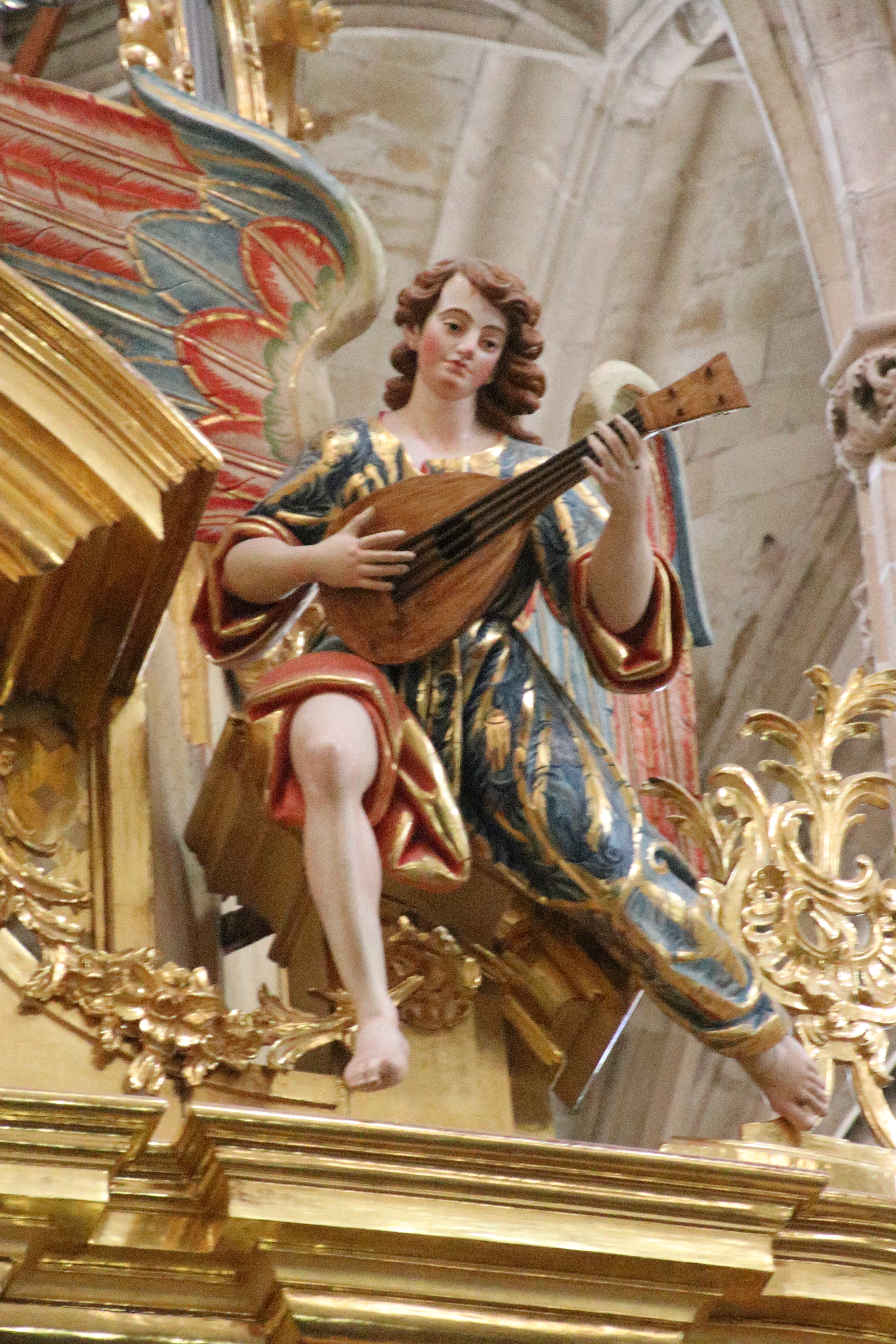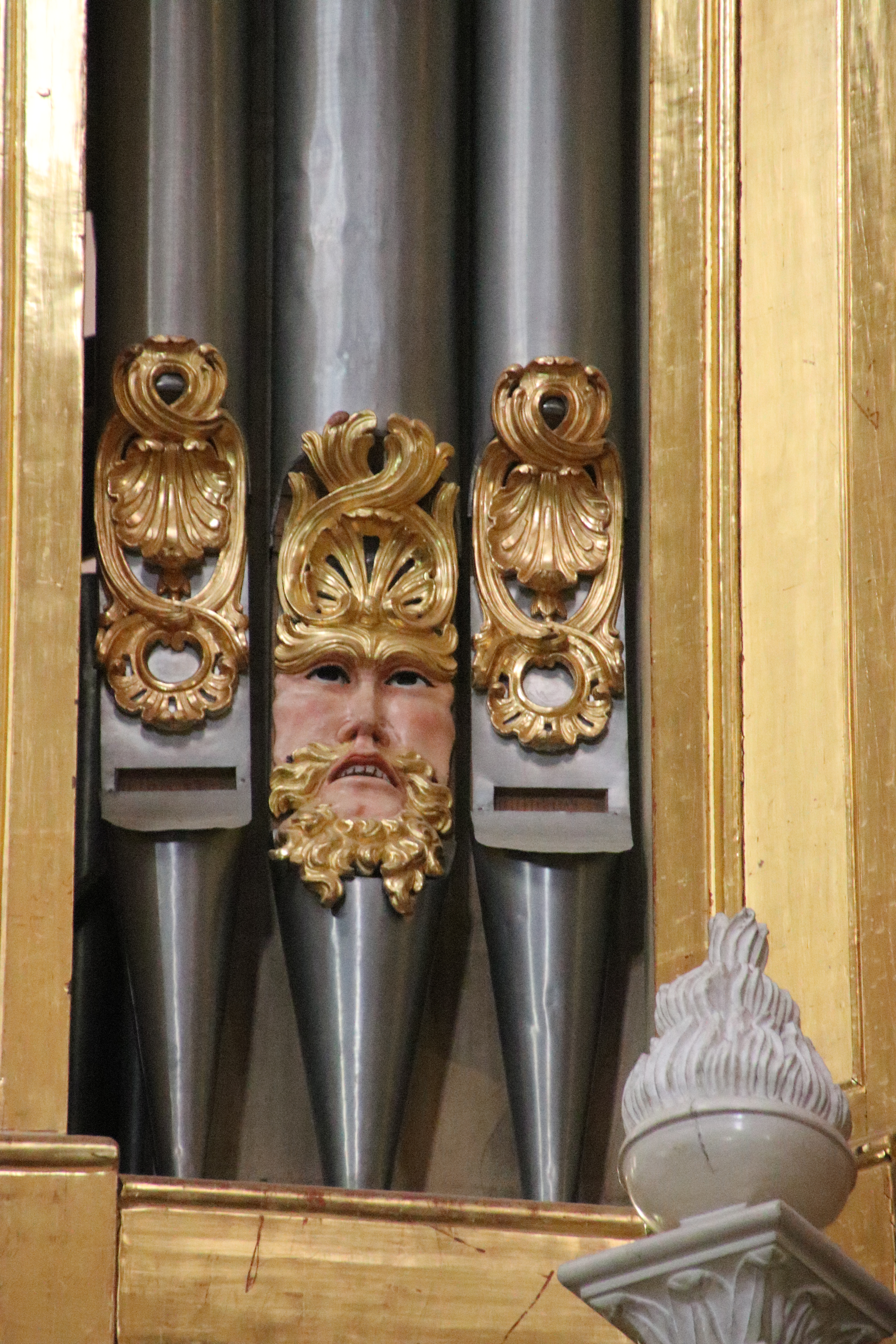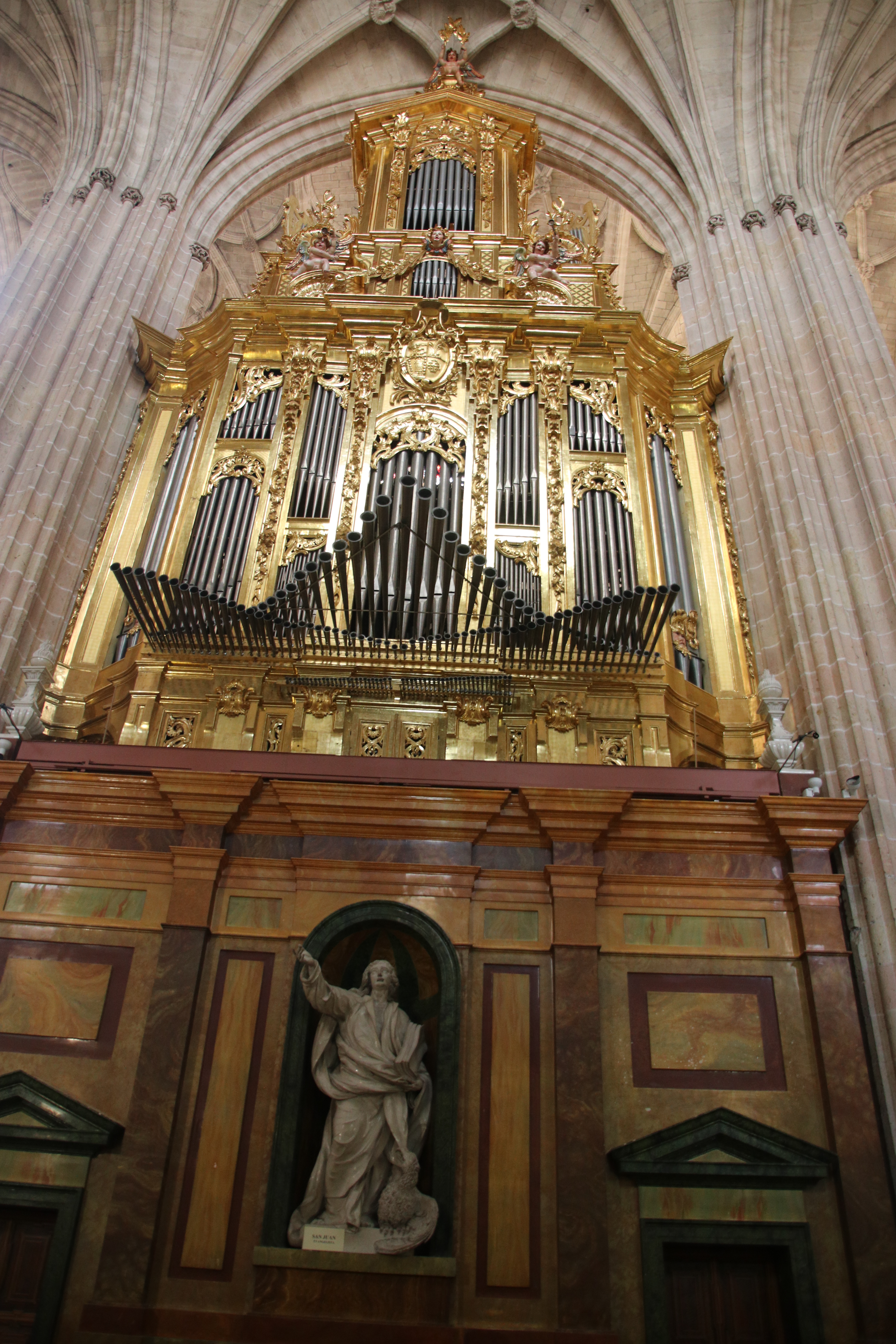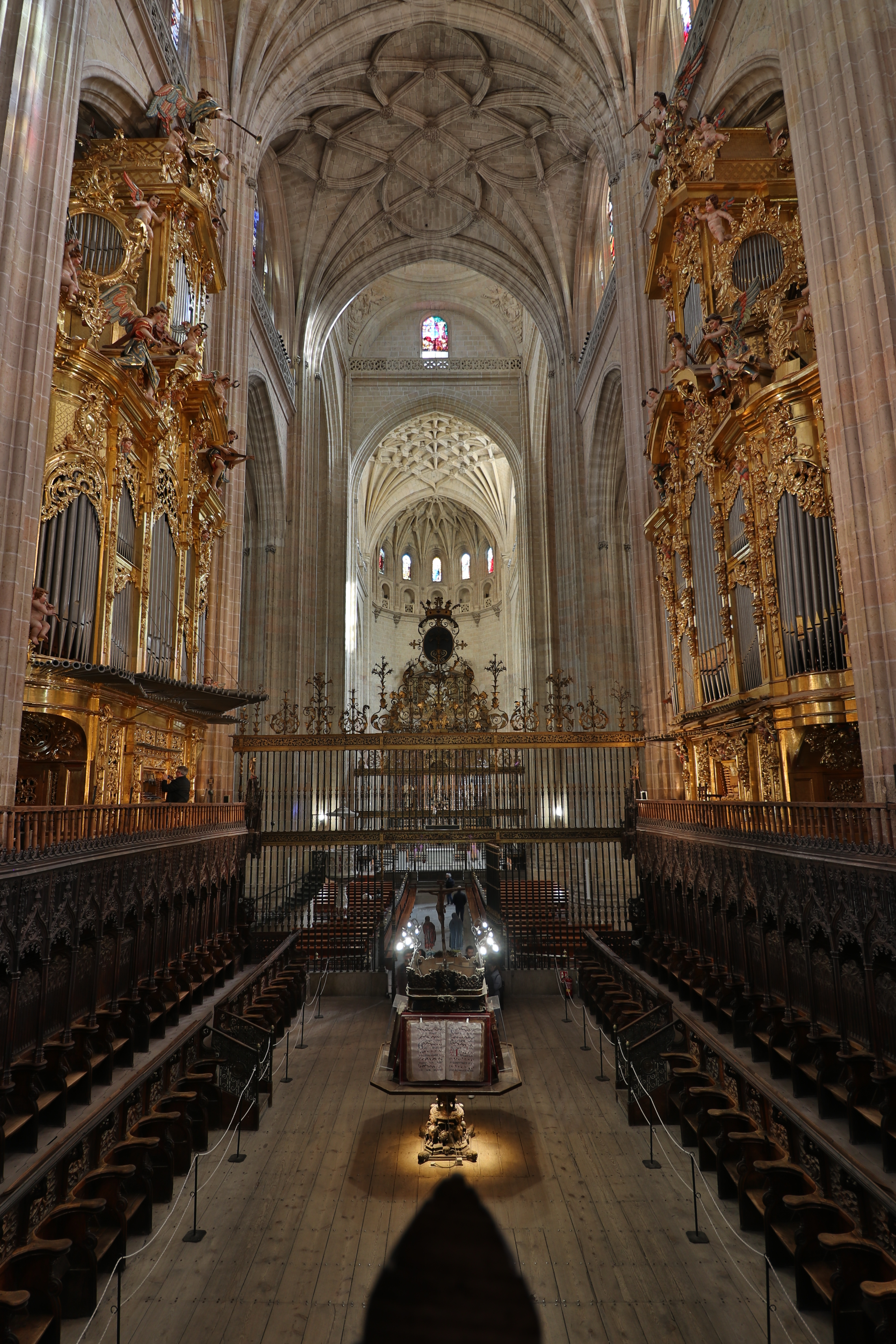Segovia, Segovia Cathedral
| Builder | J. Echevarria |
|---|---|
| Year | ca. 1772 |
| Period/Style | Baroque |
| Stops | 33 |
| Keyboards | 3+P |
| Keyaction | tracker/mechanical |
| Tuning | 1/5 Comma Meantone |
| Sampleset |
Available
 , sampled by
Sonus Paradisi
, sampled by
Sonus Paradisi
|
The Segovia Cathedral organ was built by Joseph Echevarria in 1769-1772 on the north side of the quire (the Gospel side). It is his largest preserved instrument, and one of the largest organs from the baroque period preserved in Spain. The organ represents the climax of the Iberian organ building style. It was originally contracted with Pedro Echevarría, but was built by Joseph de Echevarría, because his father died soon after the work on the organ had begun. The gilded organ case was built by Juan Maurat. The importance of this particular instrument is attested by the sad fact that other major organs of the period (Sevilla, El Escorial, Palencia etc.) were drastically altered over the course of the centuries.
As is true for all old Spanish organs, Segovia is an organ with quite a narrow use. But for that particular use - the vast musical repertoire of the Spanish baroque - it is extraordinary for its rich stop list, range of sound colors and effects, and especially for its enormous echo possibilities. The organ has two facades, creating a pronounced echo effect when the Organo Mayor plays towards the listeners in the quire (the front facade of the instrument), while the Organo Respaldo sounds in the opposite direction from the quire into the side isle (so the listeners in the quire hear only reflections off the side vaults and walls). Several stops, namely the Flautat, Trompeta batalla and Duzaina, are mounted directly on the rear facade, providing the most distant tone to the audience and creating a dramatic contrast to the facade reeds of the Organo Mayor. The effect could hardly be greater. It is also worth noting that it was the Echevarria organ building family who used horizontal facade reeds for the first time in the world.
In addition to the Organo Mayor and Organo Respaldo, the organ has a Cadereta division located deep inside the base of the organ case and capable of creating another kind of an echo. The original contract gives a detailed description of what the Cadereta's design should be in order to respond properly to echo each register of the Organo Mayor. The Cadereta is enclosed in a box that can be opened via an unbalanced pedal to the left of the pedalboard. The Favot-Obue and the Violon of the Cadereta are not enclosed on the instrument for practical reasons - the pipes are too high to be enclosed in the limited space available for the box.
The pedal division has one flue stop with 9 diatonic pipes of 16-foot pitch. The Organo Mayor is permanently coupled to the pedal.
During the course of history, some stops were changed after the fashions of the times. The most significant changes were made in 1893 by Juan Otorel during an overhaul of the organ, but thankfully many of the removed original stops were preserved at the cathedral. These were used in the restoration performed by Joaquin Lois organbuilders in 2021. They restored the instrument to Echevarria's original state; almost all of the original Echevarria parts and materials were preserved, and most of them were found in excellent condition.
The organ speaks on 74 mm of water column pressure. The temperament is 1/5 Pythagorean comma "with some proprietary modifications" according to Joaquin Lois.
As is true for all old Spanish organs, Segovia is an organ with quite a narrow use. But for that particular use - the vast musical repertoire of the Spanish baroque - it is extraordinary for its rich stop list, range of sound colors and effects, and especially for its enormous echo possibilities. The organ has two facades, creating a pronounced echo effect when the Organo Mayor plays towards the listeners in the quire (the front facade of the instrument), while the Organo Respaldo sounds in the opposite direction from the quire into the side isle (so the listeners in the quire hear only reflections off the side vaults and walls). Several stops, namely the Flautat, Trompeta batalla and Duzaina, are mounted directly on the rear facade, providing the most distant tone to the audience and creating a dramatic contrast to the facade reeds of the Organo Mayor. The effect could hardly be greater. It is also worth noting that it was the Echevarria organ building family who used horizontal facade reeds for the first time in the world.
In addition to the Organo Mayor and Organo Respaldo, the organ has a Cadereta division located deep inside the base of the organ case and capable of creating another kind of an echo. The original contract gives a detailed description of what the Cadereta's design should be in order to respond properly to echo each register of the Organo Mayor. The Cadereta is enclosed in a box that can be opened via an unbalanced pedal to the left of the pedalboard. The Favot-Obue and the Violon of the Cadereta are not enclosed on the instrument for practical reasons - the pipes are too high to be enclosed in the limited space available for the box.
The pedal division has one flue stop with 9 diatonic pipes of 16-foot pitch. The Organo Mayor is permanently coupled to the pedal.
During the course of history, some stops were changed after the fashions of the times. The most significant changes were made in 1893 by Juan Otorel during an overhaul of the organ, but thankfully many of the removed original stops were preserved at the cathedral. These were used in the restoration performed by Joaquin Lois organbuilders in 2021. They restored the instrument to Echevarria's original state; almost all of the original Echevarria parts and materials were preserved, and most of them were found in excellent condition.
The organ speaks on 74 mm of water column pressure. The temperament is 1/5 Pythagorean comma "with some proprietary modifications" according to Joaquin Lois.
| Órgano Mayor (left/right hands) | Órgano de Respaldo (left/right hands) | Cadereta (Eco) | Teclado de contras (Pedal) |
|---|---|---|---|
| Flautado de 26 | Flautado de 13 | Violón | Contras de 26 |
| Flautado de 13 | Octava | Favot/Obue | |
| Violón | Docena | Tapadillo | |
| Octava | Quincena | Dozena | |
| Repiano IV 22ª | Lleno III 22ª | Quincena | |
| Nasardos V | Zímbala | Lleno III | |
| -/Corneta VI | Trompeta real | Zímbala III | |
| -/Flauta II | Trompeta de batalla | -/Corneta V | |
| Trompeta real | Chirimía/Trompeta Magna | Tiorba/Clarín | |
| Clarín de campaña | Dulzaina | ||
| Clarín | |||
| Chirimía/Trompeta Magna | |||
| Orlo |
1699694215-Sostoa-Allegro-Segovia
0:00
0:00
1699825991-Anonymus Batalha
0:00
0:00
1699733179-I-TONO anoniem SegoviaSurr
0:00
0:00
1699793540-Anonymus Toccata
0:00
0:00
https://www.sonusparadisi.cz/en/organs/spain/segovia.html
 Pipe Organ Map
Pipe Organ Map








